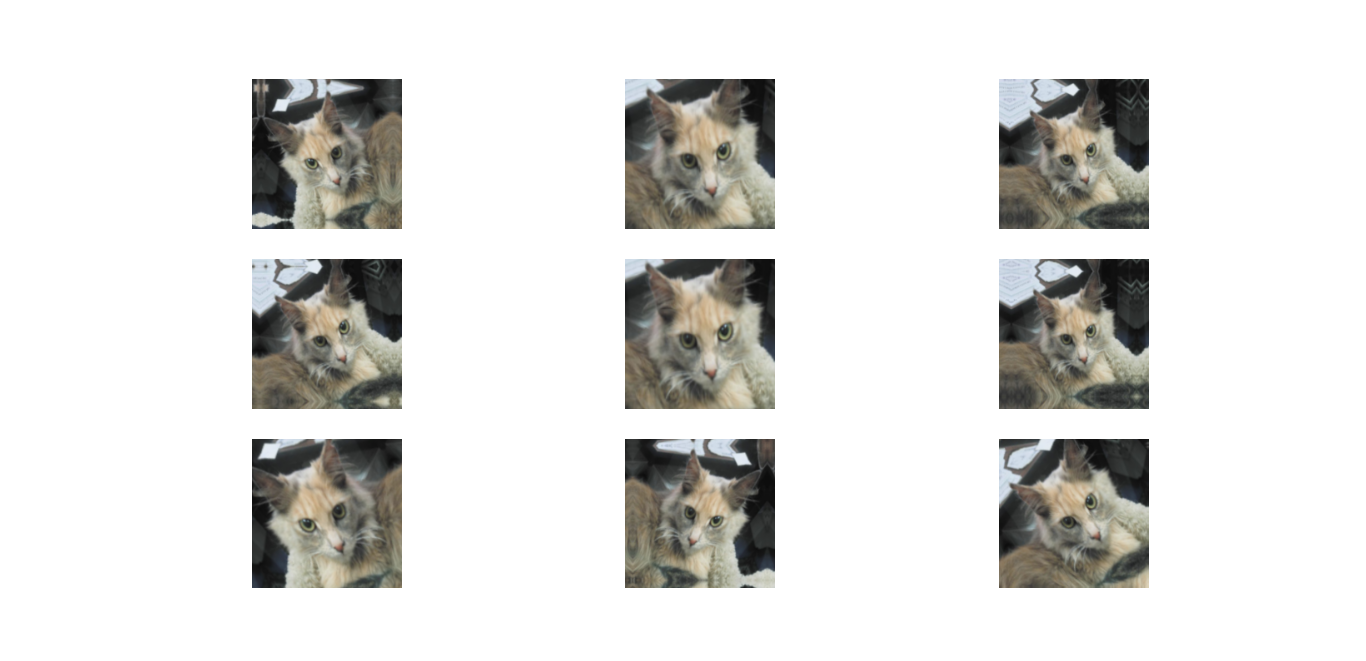深度学习笔记2:数据增强
上一节由于训练数据集样本量较小,模型过早拟合最终我们在测试数据集的分类精度只达到了70%,本章节我们通过使用数据增强降低过拟合的方法。使用数据增强之后,模型的分类精度将提高到 80%~85%。数据增强是指从现有的训练样本中生成更多的训练数据,做法是利用一些能够生成可信图像的随机变换来增强(augment)样本。数据增强的目标是,模型在训练时不会两次查看完全相同的图片。这有助于模型观察到数据的更多内容,从而具有更强的泛化能力。
数据准备
定义数据增强代码
from tensorflow import keras from tensorflow.keras import layers data_augmentation = keras.Sequential([ layers.RandomFlip("horizontal"), layers.RandomRotation(0.1), layers.RandomZoom(0.2), ])
加载数据集
import pathlib new_base_dir = pathlib.Path('C:/Users/wuchh/.keras/datasets/dogs-vs-cats-small') batch_size = 32 img_height = 180 img_width = 180 train_dataset = keras.preprocessing.image_dataset_from_directory( new_base_dir / 'train' , validation_split=0.2, subset="training", seed=123, image_size=(img_height, img_width), batch_size=batch_size ) validation_dataset = keras.preprocessing.image_dataset_from_directory( new_base_dir / 'train' , validation_split=0.2, subset="validation", seed=123, image_size=(img_height, img_width), batch_size=batch_size )
显示几张增强后的训练图像
import matplotlib.pyplot as plt
plt.figure(figsize=(10, 10)) for images, _ in train_dataset.take(1): for i in range(9): augmented_images = data_augmentation(images) ax = plt.subplot(3, 3, i + 1) plt.imshow(augmented_images[0].numpy().astype("uint8")) plt.axis("off") plt.show()

数据增强神经网络模型
inputs = keras.Input(shape=(180, 180, 3)) x = data_augmentation(inputs) #数字增强 x = layers.Rescaling(1./255)(x) x = layers.Conv2D(filters=32, kernel_size=3, activation="relu")(x) x = layers.MaxPooling2D(pool_size=2)(x) x = layers.Conv2D(filters=64, kernel_size =3, activation="relu")(x) x = layers.MaxPooling2D(pool_size=2)(x) x = layers.Conv2D(filters=128, kernel_size=3, activation="relu")(x) x = layers.MaxPooling2D(pool_size=2)(x) x = layers.Conv2D(filters=256, kernel_size=3, activation="relu")(x) x = layers.MaxPooling2D(pool_size=2)(x) x = layers.Conv2D(filters=256, kernel_size=3, activation="relu")(x) x = layers.Flatten()(x) x = layers.Dropout(0.5)(x) outputs = layers.Dense(1, activation="sigmoid")(x) model = keras.Model(inputs=inputs, outputs=outputs) model.compile(loss="binary_crossentropy",optimizer="rmsprop",metrics=["accuracy"])
训练卷积神经网络
callbacks = [keras.callbacks.ModelCheckpoint(filepath="convnet_from_scratch_with_augmentation.model", save_best_only=True,monitor="val_loss")] history = model.fit( train_dataset, epochs=100, validation_data=validation_dataset, callbacks=callbacks)
在测试集上评估模型
test_dataset = keras.preprocessing.image_dataset_from_directory( new_base_dir / 'test' , seed=123, image_size=(img_height, img_width), batch_size=batch_size) test_model = keras.models.load_model("convnet_from_scratch_with_augmentation.model") test_loss, test_acc = test_model.evaluate(test_dataset) print(f"Test accuracy: {test_acc:.3f}")
>>> test_model = keras.models.load_model("convnet_from_scratch_with_augmentation.model") >>> test_loss, test_acc = test_model.evaluate(test_dataset) 3/32 [=>............................] - ETA: 2s - loss: 0.4401 - accuracy: 0.7604Corrupt JPEG da 9/32 [=======>......................] - ETA: 1s - loss: 0.5328 - accuracy: 0.7535Corrupt JPEG da32/32 [==============================] - 2s 69ms/step - loss: 0.4752 - accuracy: 0.7890 >>> print(f"Test accuracy: {test_acc:.3f}") Test accuracy: 0.789 >>>
这次我的测试精度达到了 78.9%,这个进步不少!





【推荐】国内首个AI IDE,深度理解中文开发场景,立即下载体验Trae
【推荐】编程新体验,更懂你的AI,立即体验豆包MarsCode编程助手
【推荐】抖音旗下AI助手豆包,你的智能百科全书,全免费不限次数
【推荐】轻量又高性能的 SSH 工具 IShell:AI 加持,快人一步
· 震惊!C++程序真的从main开始吗?99%的程序员都答错了
· 【硬核科普】Trae如何「偷看」你的代码?零基础破解AI编程运行原理
· 单元测试从入门到精通
· 上周热点回顾(3.3-3.9)
· winform 绘制太阳,地球,月球 运作规律